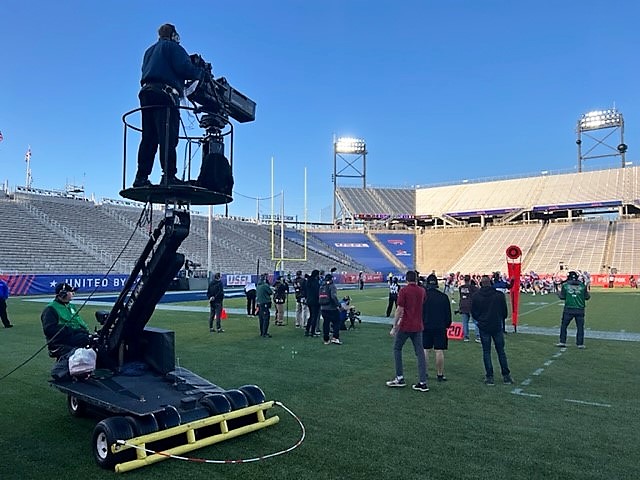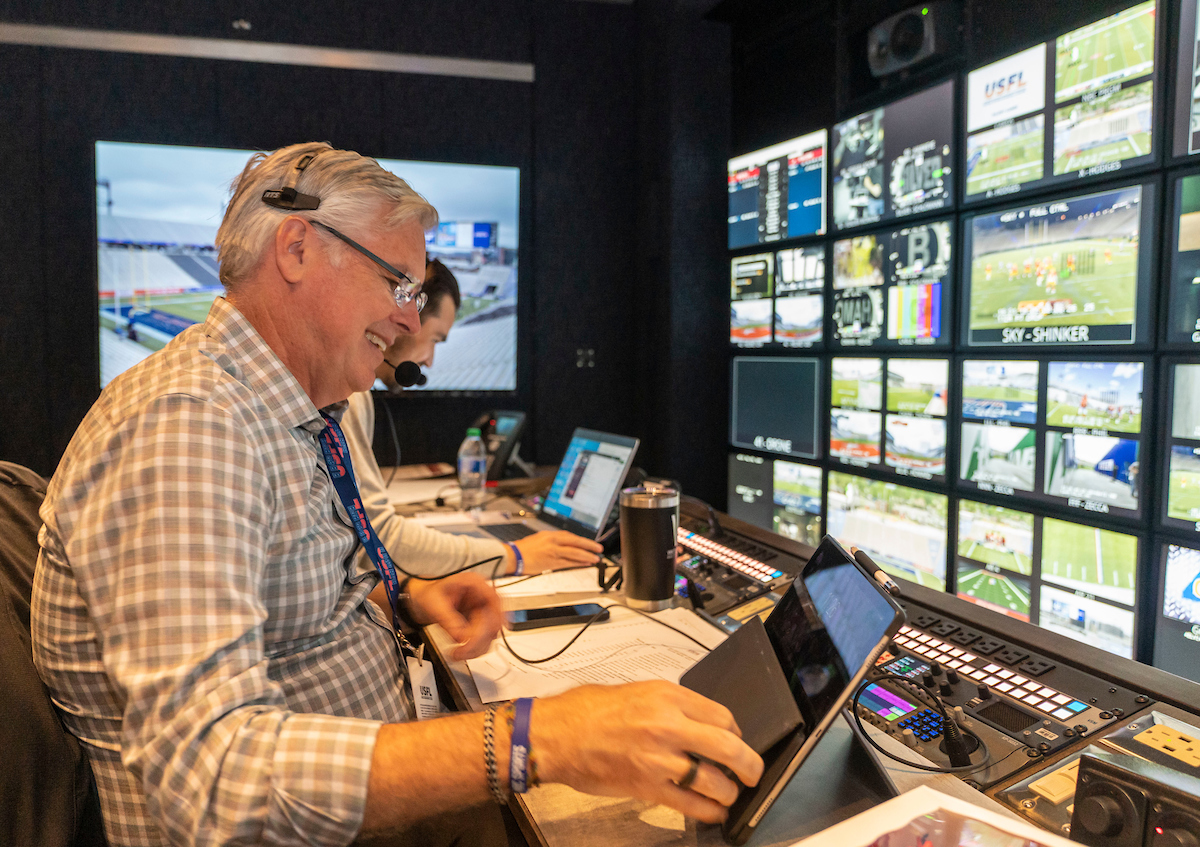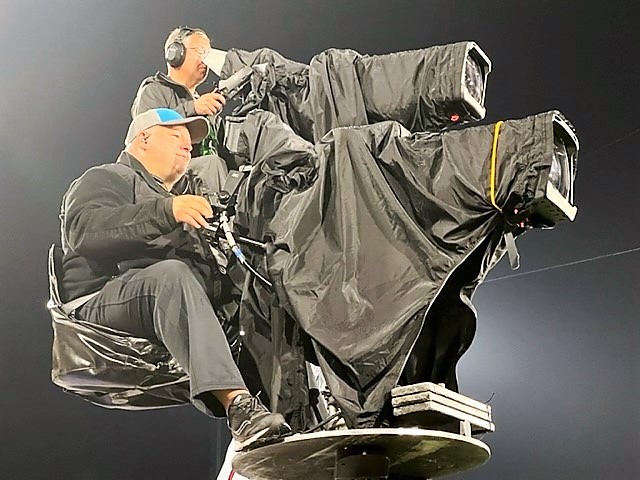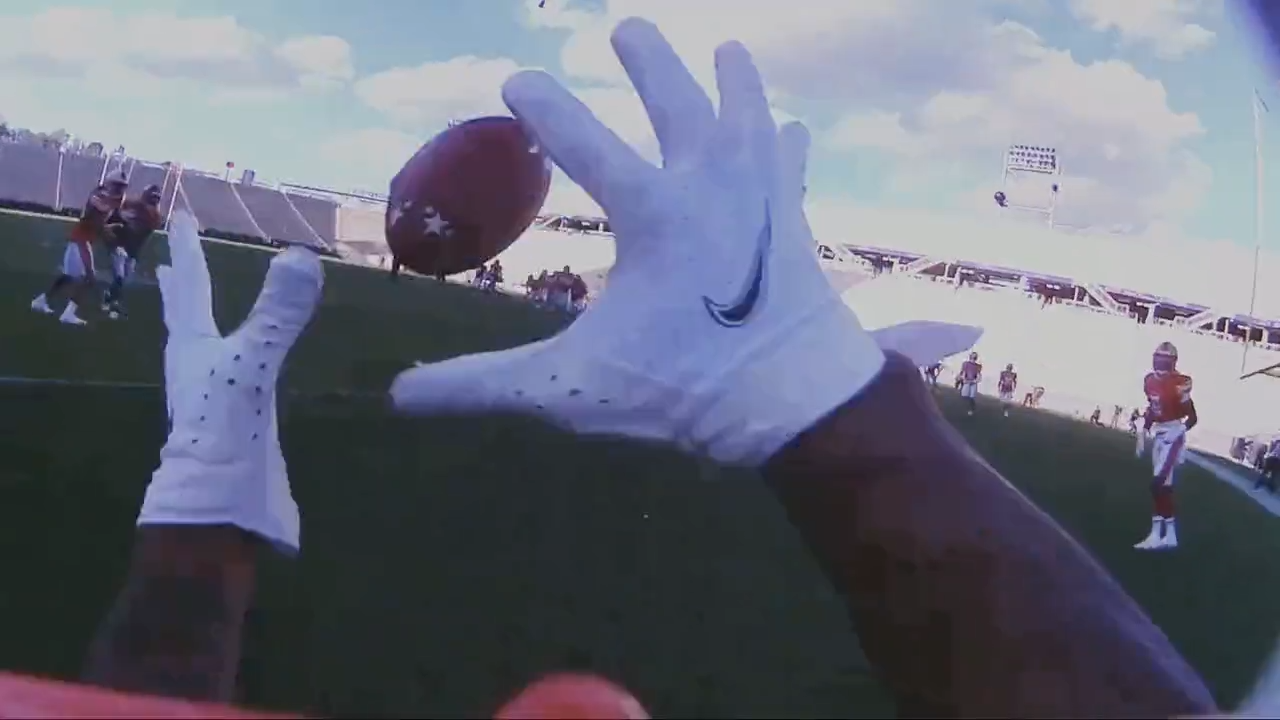Fox Sports, NBC Sports Team Up On USFL Production
Not only do the broadcasters share production resources but also on-site REMI workflows

BIRMINGHAM, Ala.—At about midway through the inaugural United States Football League (USFL) season, the well-known television production technique dubbed REMI, or Remote Integration Model, is once again proving itself to be invaluable—but this time with a twist.
Rather than simply offering an alternative to traditional on-site TV production, the same REMI implementation serves centralized production control in Los Angeles for FOX Sports and Stamford, Conn., for NBC Sports as well as the league itself in Los Angeles, powering USFL replay, which is done under contract by Fox.
“To do that really involved an absolute plethora of transmission gear and real deep network insight into both [network television] workflows and concepts,” says Brad Cheney, vice president of field operations and engineering at Fox Sports.
More than 120 feeds leave Birmingham via 19 gigabits of bandwidth, a combination of private and public circuits as well as satellite backup. About half land simultaneously in Stamford and Los Angeles and the other half are discrete to each location. Even though separate game productions are done in Stamford and Los Angeles, remotely doing replay on the West Coast means both locations are always on.

“Even when NBC is doing a show, you couldn’t just flip the switch and send all transmission to NBC and call it a day,” says Cheney. “Those cameras come back in real time to Los Angeles for the replay center…. All of that depth of access that we built for the show is interacting with NBC Stamford full time. From that level, the integration is absolutely peer-to-peer constantly.”
The ‘New’ USFL And TV Production
The “new” USFL kicked off its first season in April with eight teams playing a 10-game schedule. The word “new” is being applied to this incarnation of the league because the idea of a second professional football league has been around for decades. The USFL traces its historical roots to 1965 when David Dixon, a businessman in New Orleans, conceived the idea for a pro league that played during the summer in NFL and college football off-seasons. That league actually formed and played three seasons, 1983-1985, before folding.
The new league, which reportedly is owned by Fox Sports through a business entity called The Spring League, is being led by Brian Woods, its co-founder and president, and Daryl Johnston, USFL executive vice president of football operations and a former Dallas Cowboys fullback who played on three Super Bowl championship teams.
Get the TV Tech Newsletter
The professional video industry's #1 source for news, trends and product and tech information. Sign up below.
All regular season games are being played in Birmingham. Three postseason games will be played as well, concluding July 3 with the USFL Bowl, which will be played at Tom Benson Hall of Fame Stadium in Canton, Ohio, adjacent to the Pro Football Hall of Fame.
The teams are divided into two divisions, which include the Michigan Panthers, New Jersey Generals, Philadelphia Stars and Pittsburgh Maulers in the north and Birmingham Stallions, Houston Gamblers, New Orleans Breakers and Tampa Bay Bandits in the south.
Centralizing regular season play in one city—as opposed to playing in four different cities each week—means there was no need to roll traditional OB trucks across the country from venue to venue. REMI was a good fit, says Cheney.
The first week of the season was an exception with traditional mobile facilities on site at the 47,000-seat Protective Stadium where the University of Alabama, Birmingham, Blazers play. Legion Field, the former home of the UAB Blazers, is also being used.
There were remotely produced elements added for the first two games of the inaugural weekend, however. NBC Sports added quarterback stats, scorebug, production and commentator telestrators, from Stamford. The third game that weekend between the Philadelphia Stars and New Orleans Breakers was produced entirely in Stamford.
Fox Sports began to prepare for USFL production preparations in December 2021. Two weeks later, the sports broadcaster’s CEO Eric Shanks and Brad Zager, its president of production and operations/executive producer, came to Cheney and his team with a new development.
“They said, ‘Hey, by the way, we’ve got a second television partner, NBC, and we’re going to do it all together,’” recalls Cheney.
Enter NBC Sports
Fresh off its overlapping production of the Winter Olympics from Beijing and Super Bowl LVI from SoFi Stadium in Los Angeles, NBC Sports took on production of USFL games in partnership with Fox Sports.
For its productions, NBC Sports is using more than 68 video paths from Birmingham to Stamford, says Craig Bernstein, the sports broadcaster’s vice president, remote technical operations and engineering.
Relying on a combination of compression codecs, including JPEG2000, HEVC and H.264, NBC Sports has reduced latency between the stadium and Stamford to “nearly a non-factor,” he says.
From a production point of view, the broadcasters are using nearly 60 cameras to cover the biggest games—comparable to the number used for NFC and AFC championship games—and no fewer than 30 for others, says Cheney.

In the case of Fox Sports, 70 microphones are capturing audio on the field. NBC Sports has added three additional stereo microphones—high left end zone, high right end zone and far 50-yard Mezzanine level—to create and capture enhanced sound. The broadcaster is creating a 5.1.4 mix in Stamford, which is being mixed down to 5.1 for air, says Bernstein.
Games are being shot in 1080p HDR. NBC is distributing 1080i HD to viewers, Fox is distributing its shows in 4K to affiliates and cable partners. Most Fox affiliates are down converting to 720p for broadcast, but some are also on-air in ATSC 3.0, which supports 4K. “I believe some of them are also doing so (broadcasting the games in 4K) and some are leveraging their cable partners,” says Cheney.
New Perspectives
Specialty cameras play a big role in production of the games. Helmets are equipped with cameras as are referee hats. There are also wireless line-to-gain pylon cams, drone cameras, says Bernstein. The Ump cameras are particularly valuable, adds Cheney.

“One thing people forget … [with] the helmet cam is when you're running with a football, your helmet is moving side to side, because you’re looking ahead to see what's going on, see where that hole is, as you're moving,” says Cheney. “While we get some really amazing things on it, it can also give you motion sickness at the same time.”
In contrast, the Umpires stand still and are focused. “You really see the play at head level coming at you,” he adds.
Among the most noticeable shots are those from a dual SKYCAM setup—with one positioned high and the other low, similar to what NBC Sports uses in its “Sunday Night Football” productions. While using two SKYCAMs isn’t new in football production, the impact of positioning one from the defensive point of view and the other from the offense’s perspective “is massive,” says Cheney.
With the defensive side SKYCAM, producers can zoom in and ISO on players running towards the camera—“something we’ve never been able to do before,” says Cheney.
“Now all of a sudden, we have a moving end zone camera,” he says. “We’ve put a 24x lens on it, and it’s in people’s noses. And because of the other coverage cameras there, even the low sky camera on the offensive side of the play runs lower, doing more and pushing things a bit.”
While the producers and technical staff come from different networks, both NBC Sports and Fox Sports have worked well together, learning from one another and synthesizing new perspectives into the production of each of their shows. Even with production of the opening game—a simulcast by both Fox and NBC—both sides worked closely together.
“That night we were launching that simulcast, Brad Zager and (NBC Sports executive producer and president, production) Sam Flood were sitting next to each other the whole time, discussing what to do—how to make the show,” says Cheney.
Bernstein echoes Cheney’s comments. “Working with our partners at Fox has been both a unique and rewarding experience, including working together to engineer dual solutions using a common set of equipment and personnel. I’m looking forward to continuing the partnership as the league continues to gain traction,” he says.
Phil Kurz is a contributing editor to TV Tech. He has written about TV and video technology for more than 30 years and served as editor of three leading industry magazines. He earned a Bachelor of Journalism and a Master’s Degree in Journalism from the University of Missouri-Columbia School of Journalism.

